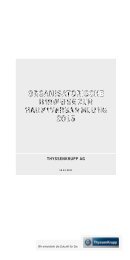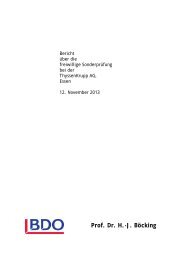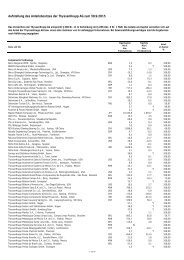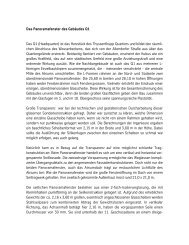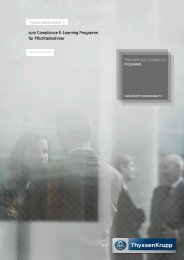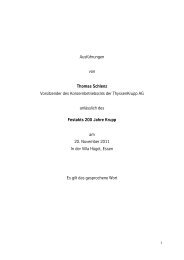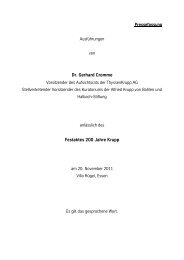PDF (10.9MB) - ThyssenKrupp AG
PDF (10.9MB) - ThyssenKrupp AG
PDF (10.9MB) - ThyssenKrupp AG
Create successful ePaper yourself
Turn your PDF publications into a flip-book with our unique Google optimized e-Paper software.
3.6 Consolidated financial statements Notes to the consolidated financial statements<br />
3.6 Consolidated financial statements Notes to the consolidated financial statements<br />
Impairments in the form of individual allowances for doubtful accounts<br />
adequately consider default risk. When there is objective evidence of<br />
default, the receivable concerned is derecognized. Receivables that are<br />
immaterial, and receivables of similar default risk, are grouped<br />
together and tested collectively for impairment based on past<br />
experience. Partially, impairments are accounted for using separate<br />
allowance accounts. Whether default risk is recognized by means of an<br />
allowance account or a direct derecognition of the receivable depends<br />
on the probability of default and the reliability of its estimation.<br />
Receivables that do not bear interest or bear below market interest<br />
rates and have an expected term of more than one year are discounted<br />
with the discount subsequently amortized to interest income over the<br />
term of the receivable.<br />
The Group sells undivided interests in certain trade accounts and notes<br />
receivable both on an ongoing and one-time basis to special purpose<br />
entities, which are not required to be consolidated, or to other lending<br />
institutions. Financial assets sold under these arrangements are<br />
excluded from accounts receivable in the Group’s balance sheet at the<br />
time of sale if it is assured that the cash flows related to those<br />
receivables will be passed through to the acquirer and substantially all<br />
risks and rewards have been transferred. If substantially all risks and<br />
rewards have neither been transferred nor retained, financial assets<br />
are excluded from the books at the time of the sale if it is assured that<br />
the cash flows of the receivables will be passed through to the acquirer<br />
and the acquirer has gained control over the receivables. If<br />
substantially all risks and rewards have been retained financial assets<br />
remain in the Group’s balance sheet as collateral for borrowings.<br />
Cash and cash equivalents<br />
Cash and cash equivalents include cash on hand and demand deposits<br />
as well as financial assets that are readily convertible to cash and<br />
which are only subject to an insignificant risk of change in value, they<br />
are measured at amortized cost.<br />
Financial assets held for trading<br />
Derivatives that are not part of an effective hedge accounting in<br />
accordance with IAS 39 must be assigned to this category when the<br />
fair value is positive as of measurement date. Gains or losses resulting<br />
from changes in fair value are recognized in profit or loss.<br />
Available-for-sale financial assets<br />
Available-for-sale financial assets are those non-derivative financial<br />
assets not assigned to any of the above categories (trade accounts<br />
receivable and other current receivables, cash and cash equivalents,<br />
and financial assets held for trading). This category includes primarily<br />
equity and debt instruments which are in general measured at fair<br />
value. Gains or losses resulting from the measurement of available-forsale<br />
financial assets are recognized directly in equity, with the<br />
exception of impairment losses and foreign currency conversion<br />
effects. On disposal of these financial assets, a cumulative gain or loss<br />
recognized directly in equity until then is recognized in profit or loss of<br />
the respective period. When the fair value of unlisted equity<br />
instruments cannot be reliably measured, they are measured at cost.<br />
Financial assets measured at fair value through profit or loss<br />
The Group does not use the option to categorize financial assets at fair<br />
value through profit or loss when initially recognized.<br />
Impairment of financial assets<br />
At each balance sheet date, an assessment is made of whether there<br />
is any objective evidence that the carrying amounts of financial assets<br />
not carried at fair value through profit or loss are impaired. Objective<br />
evidence includes, for example, considerable financial difficulty of the<br />
debtor obligor, disappearance of an active market, and significant<br />
changes in the technological, market, economic or legal environment.<br />
A significant or prolonged decline in the fair value of an equity<br />
instrument is an objective evidence of impairment.<br />
The impairment loss on a financial asset carried at amortized cost is<br />
measured as the difference between the asset’s carrying amount and<br />
the present value of estimated future cash flows discounted at the<br />
financial asset’s original effective interest rate. An impairment loss is<br />
recognized in profit or loss.<br />
138



